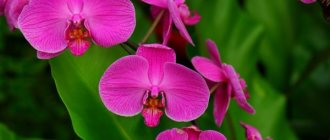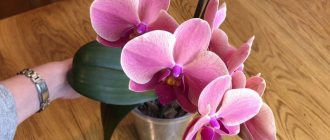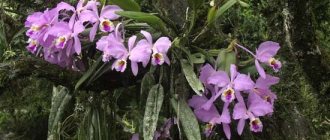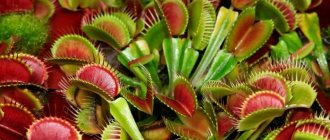Many people are interested in the question: is there a natural orange orchid? Yes, these gorgeous flowers are truly completely natural.
There are several types of orange orchids. Plants of this color range from yellow to bright red. In nature, there are 50 varieties with this bright shade. Fiery red phalaenopsis are in demand among orchid lovers. But you need to know that plants should not have a very bright tone. Unscrupulous manufacturers may color plants artificially. If it is a fake, then there are spots on the flower shoot and leaves that are visible to the naked eye.
The plant is checked for the presence of injection marks under the foliage, at the base of the peduncle. Inspect the root system, which normally has a silvery-greenish color.
How to choose?
The most varied shades of orchids are called orange. Dark yellow with orange tints, orange with tints of red and pink, and scarlet are the shades of the orchid, which is sold under the name orange.
When buying an orange orchid, be vigilant and do not let florists deceive you. They often pass off a painted flower as a real one. Such a plant will either bloom white or die.
When choosing an orchid in a store, pay attention to the roots . Their color should be natural, there should be no puncture under the leaves, on the peduncle or neck of the flower.
Cattleya
The incredibly beautiful cattleya has large flowers with a bright velvet lip and a pleasant aroma that bloom for a long time.
Examples of orange cattleya:
- Orange-red Cattleya (Cattleya auraptiaca);
- Cattleya Forbesii.
Cattleya auraptiaca:
Cattleya forbesii:
The stem of this orchid is thick, intertwined or cylindrical in shape, on which there are up to 3 leaves of a leathery structure.
Varieties with bright colors and their photos
There are a huge number of varieties of orange orchids, but among them there are several species that stand out for their beauty. These flowers are easy to grow at home.
Cattleya
The most beautiful of orange orchids. It has large yellow-red inflorescences and a velvety orange lip. The plant needs temperature changes and abundant watering in summer .
We invite you to watch a video about the Cattleya orchid:
Ascocenda
A hybrid created by crossing Ascocentrum and Vanda plants. The plant has bright orange large inflorescences, which are collected in brushes. Leaves are rich green.
Ascocenda is too picky. It takes a lot of effort to see it bloom and grow it. She needs excellent lighting at least twelve hours a day, sudden changes in temperature.
Particular attention should be paid to the fact that Ascocendra needs to be watered a lot and only with warm water .
We invite you to watch a video about the Ascocendra orchid:
Wanda
Capricious, but popular due to its pure orange color. Needs plenty of sunlight, ventilation and fertilizer. Loves high humidity. The roots must be left open so that they do not rot .
Brassada
Hybrid of Ada Aurantica and Brassia. The bright orange buds of Ada Aurantica were inherited by Brassade. Likes it when it's cool, dark and humid. If you provide it with these conditions, then in the summer you can see how beautifully it will bloom. Her flowers will delight you for more than a month.
Cymbidium
A tall orange orchid whose leaves are long and pointed. From spring to autumn, watering should be plentiful. The soil must not be allowed to dry out. The plant does not need high humidity .
We invite you to watch a video about the Crimbidium orchid:
Vanda
Vanda has an attractive coloration. Its hard, cylindrical stem, up to 1 meter long, is densely covered with oppositely spaced, belt-shaped or rolled leaves with a green color and one apex.
Popular varieties:
- Vanda “Nopporn Orange Rozy Orange Beauty”;
- Vanda "Natcha Mandarin";
- Vanda "Natcha Princess Orange";
- Vanda “Natcha Magic Orange”.
Vanda Nopporn Orange Rozy Orange Beauty:
Vanda Natcha Mandarin:
Vanda Natcha Princess Orange:
Vanda Natcha Magic Orange:
Depending on the type (variety), they have a length from 25-30 cm to 1 meter. Peduncles have both many and few flowers.
The uniqueness of Vanda lies in the fact that the blooming flowers continue to grow and acquire brighter colors for several more days.
Rules of care
The plant will take root if it is installed on a windowsill that faces the west or east. The maximum temperature in summer should not exceed 30ºС, and in winter not less than + 14ºС.
It will be necessary to organize additional lighting if it is cold and dark for the plant on the window in winter.
The soil for planting an orange orchid must be specially prepared. You will need pine bark, wood charcoal and sfangoon moss. Choose a transparent pot for the flower with holes for drainage, because air is important for the roots.
Water the orchid generously with warm water . At low temperatures and when there is little light, watering should be done less often so as not to destroy the plant.
History of breeding
Phalaenopsis was discovered and given its name in 1825, due to an error by the scientist Karl Blume. He mistook the flowers for a flock of butterflies, which for some reason did not fly when he came close. This is how the name appeared, which translated means “like a butterfly.” And in India, the same plant received the name “moon flower”.
Reference! Since 1925, active cultivation and selection of these flowers began, thanks to which today there are more than 70 varieties.
Transfer
To maintain a healthy root system, the orange orchid must be properly replanted after it has finished flowering. Transplant stages :
- When removing a flower from a pot, do not allow severe damage.
- Wash off the lump of earth with water.
- Remove damaged roots.
- Leave stumps when cutting leaves that have dried out.
- Dry the flower for three hours before planting.
Thanks to replanting, the mineral supply will not be depleted, the acidity will not increase, and the plant will avoid poisoning.
Phalaenopsis (Phalaenopsis I-Hsin Salmon 'Copper Star')
This beautiful representative of the orchid family is intended for home cultivation. Phalaenopsis is a monopodial (stemless) orchid that grows slowly in height. Belongs to the genus of herbaceous epiphytic plants.
The flowers are brightly colored, the lip is pink, the peduncle is half a meter high and can bear up to 14 inflorescences.
Pests and diseases
Caring for an orange orchid must be correct, otherwise the appearance of pests and diseases will be inevitable. If the leaves of a plant begin to turn yellow, then this is a signal of disease . Yellowness indicates incorrect temperature, insufficient moisture and light. It is not recommended to overcool the flower for a long time. This leads to his death.
If spots appear on the leaves and a specialist identifies a viral disease, then the flower must be destroyed. This will help protect other flowers from viruses that can be spread by insects. Viral diseases are incurable.
Bacterial blotch appears as dark-colored spots and softened leaves. In this case, the sore spots are cut off and cauterized with iodine.
Fungal diseases are soil-borne . They are difficult to treat, so it is better to prevent them. If you constantly ventilate the room, avoid excess moisture, and do not leave water on the leaves, you can prevent such diseases.
When a plant is weakened, it can become infested with mealybugs and aphids. Pests can be destroyed only with those drugs that are recommended for orchids.
Lycaste aromatica
This is a variety of orchid that grows horizontally (like a grapevine). The flower has small, round, pear-shaped, often flattened pseudobulbs. The long leaves are elliptical in shape and have a folded surface.
Fragrant lycaste, with yellow-orange coloring of flowers, is popular in home floriculture lycaste, emitting a pleasant aroma. They come with both large and small flowers.
The variety Lycaste Bradeorum is very charming.
Lycaste aromatica:
Lycaste Bradeorum:
Hybrids
Botany is full of surprises.
One of the pleasant discoveries was the easy crossing of different types of phalaenopsis with each other, in which previously unknown shapes and shades of colors appear.
Industrial cultivation and sale dictates its own rules .
Absolutely identical ideal plants on a store shelf are most likely clones of a successful hybrid .
When crossing different types of phalaenopsis, such beautiful hybrids are obtained.
Biologists are striving to obtain new combinations of specks , unusual petal shapes and contrast with the lip.
Thousands of orchid hybrids can be described in the form of an encyclopedia in several volumes rather than within the confines of a single article.
Groups are distinguished and type of flowering.
Miniature
Flowers are not for a bouquet, but to take home , look after and care for, that’s what mini phalaenopsis is.
Before the creation of this group of hybrids, orchids were most often cut for bouquets.
A plant that is small in size and height is easier to maintain. Fragile flowers do not lose their grace and evoke tenderness.
Taiwanese
Bright, large, even provocative tropical flowers , unlike the first hybrids of porcelain-flat flowers.
A play of nature that imitates the work of a calligraphy master, but in reality it is the painstaking work of botanists .
Taiwan Phalaenopsis 'Red Cat'.
Of course, they are unpretentious to indoor growing conditions, because their creators took care of this.
This direction of orchid hybridization is rapidly developing. New color options for are appearing .
Very popular are species in which the corolla of petals and lip are painted in contrasting shades.
Botanists have managed to achieve previously inaccessible golden-yellow, peach, and orange phalaenopsis flowers, and something new appears .
Novelty
A group of hybrids distinguished by type of flowering.
The flower raceme is very compact, raised above the rosette of leaves.
Taiwan Novelty Phalaenopsis.
At the same time, the plant produces two or more flower stalks.
This group of hybrids contains all the variety of colors developed over the years of work by biologists.
Blots, strokes, dashes and other food for imagination on dense petals of the correct shape.
Differences from other species
The middle type of phalaenopsis can be classified as Multiflora. The orchid has a feature that distinguishes it from other species - while young leaves begin to grow, old leaf blades wither. Also characteristic features include the absence of a growth point, which was mentioned just above.
Flower arrows are also unusual - they have the ability to branch during flowering, forming a large number of shoots with buds.











